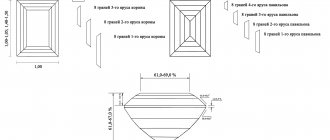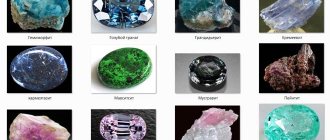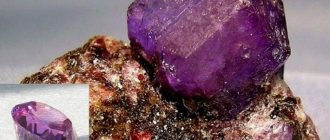Ecology
Mysterious rocks that somehow move across the dry, cracked surface of Death Valley in California, USA have puzzled scientists for decades.
On the dry lake Racetrack Playa
, stones weighing more than 300 kg leave traces in the sand up to 250 meters long
.
These sliding or crawling stones not only move themselves, but also do so in different directions. So two stones can start moving at the same time, but one of them stops or changes direction. Some stones even begin to move back.
Traces no wider than 30 cm and less than 2.5 cm deep
the rays they leave behind can take many years to form, although no one has observed this.
The mysterious force that makes these stones move remained a mystery until recently. However, NASA geologists said they had finally solved it.
Description of the valley and stones
Most of the sliding stones fall to the bottom of the dry lake from a 260 m high dolomite hill located at the southern end of Racetrack Playa. The mass of stones reaches several hundred kilograms. The tracks trailing behind them are several tens of meters long, 8 to 30 cm wide, and less than 2.5 cm deep.
The stones move only once every two or three years, with most of the tracks remaining for 3–4 years. Rocks with a ribbed bottom surface leave straighter marks, while rocks on the flat side wander from side to side. Sometimes stones turn over, which affects the size of their footprint.
Death Valley
Tourism
Death Valley Park (America, California) is considered the largest in the region. The service and infrastructure there are organized at a high level. For those who want to enjoy the amazing scenery, there is the opportunity to stay in one of the hotels or choose a campsite with guest houses. Routes, tracks and paths are laid out and thought out for the convenience of tourists in such a way as to maximize the beauty of the surrounding places.
The park consists of two valleys surrounded by mountain systems. Significant are Telescope Mountain and Dantez View. The most visited part of the valley is Furnes Creek. To make the journey easier, you can ride a horse. This will allow you not to be distracted by the difficulties of the transition and focus on the landscape: snowy peaks, rocks, canyons, salty plateaus, lakes.
For those who like to tickle their nerves, there is a route to the abandoned Riolight - a “city of ghosts” abandoned by prospectors almost a hundred years ago. The crater of the Ubehebe volcano, which died out seven thousand years ago, is almost a kilometer wide and 200 m deep and also attracts attention, as do the “crawling” stones at the bottom of Lake Racetrack Playa.
First studies of the phenomenon
Until the beginning of the 20th century, the phenomenon was explained by supernatural forces, then during the formation of electromagnetism, an assumption arose about the influence of magnetic fields, which, in general, did not explain anything.
In 1948, geologists Jim McAlister and Allen Agnew mapped the location of the stones and noted their tracks. A little later, employees of the US National Park Service compiled a detailed description of the place, and Life magazine published photographs from Racetrack Playa, after which attempts began to explain the movement of the stones.
Most hypotheses agreed that wind, when the surface of the lake bottom was wet, at least partly explained the phenomenon.
In 1955, geologist George Stanley of the University of Michigan published a paper arguing that the rocks were too heavy for local winds to move. He and his co-author proposed a theory according to which, during the seasonal flooding of a dry lake, an ice crust forms on the water, promoting the movement of stones.
Data
Are there moving rocks anywhere else on the planet? Death Valley (USA) is unique in its own way. However, information about such movements came at different times and from other places on the planet. The history of the Blue Stone and its Far Eastern brother is known. Near Semipalatinsk in Kazakhstan and in the foothills of Alatau there are crawling cobblestones. In Tibet, the Buddha Stone, weighing more than a ton, has been moving up and down in a spiral for one and a half thousand years.
What happens at the bottom of Racetrack Playa Lake? This flat area is located at an altitude of more than one kilometer above sea level. The bottom of the lake, with a length of 4.5 km and a width of 2.2 km, has a slope of only 1-2 cm per kilometer. Cobblestones are scattered randomly in this area. The vast majority of them rolled down from the dolomite hills. All stones are of different sizes and weights (up to several hundred kilograms).
It has been established that these blocks move along the surface. The actual movement was not recorded on video. However, there is no doubt that they “travel” without human help. It is impossible to determine or predict the onset of movement. Cobblestones “come to life” every few years. If you're lucky, you can see positions updated every year. It was not possible to reliably determine what the movements are associated with, but it was noted that their activity is mainly manifested in winter.
Sharp and Carey Research
In May 1972, Robert Sharp (Caltech) and Dwight Carey (UCLA) began a rock tracking program.
Thirty stones with relatively recent tracks were marked and their starting positions indicated with pegs. Over 7 years of research, scientists have developed a theory according to which the water that accumulates in the southern part of the lake during the rainy season is carried by the wind along the bottom of the dry lake and wets its surface. As a result, the hard clay soil becomes very wet and the coefficient of friction sharply decreases, which allows the wind to move even one of the largest stones (called Karen) weighing about 350 kg.
Hypotheses of movement using ice were also tested. Water driven by the wind can become covered with an ice crust at night, into which stones located in the path of the water freeze. The ice around the stone could increase the cross-section of interaction with the wind and help move the stones along the water flows.
As an experiment, a pen with a diameter of 1.7 m was created around a stone 7.5 cm wide and weighing 0.5 kg with a distance between the fence supports from 64 to 76 cm. If a layer of ice formed around the stones, then when moving it could catch on the support fence and slow down or change the trajectory, which would affect the trail of the stone.
Moving stones in the valley of death
However, no such effects were observed - in the first winter, the stone passed next to the fence support, moving 8.5 m to the northwest beyond the fenced area.
The next time, two heavier stones were placed inside the pen - after five years, one of them moved in the same direction as the first, but the second did not budge during the period of research. This suggested that the ice crust affects the movement of stones only if it is small.
Ten of the marked stones moved in the first winter of research, with stone A (which was called Mary Ann) crawling 64.5 m. It was noted that many stones also moved in the next two winters, and stood still in the summer and other winters. After 7 years, only two out of 30 observed stones did not change their location.
The smallest stone (Nancy) was 6.5 cm in diameter, and it moved the maximum total distance - 262 m, and then in just one winter - 201 m. The most massive stone, the movement of which was recorded, weighed 36 kg.
Is this phenomenon explained from a scientific point of view?
For a long time, scientists have been trying to unravel the mystery of moving boulders. Currently there are 3 hypotheses:
- The stones move due to rainfall. From time to time, heavy rains occur in Death Valley, which turns its desert surface into a clay swamp. Scientists suggest that the slippery clay mass is an excellent basis on which stones, driven by the wind, begin to roll. However, this theory does not explain how large specimens weighing more than 200 kg can move.
- Strong wind. There is an assumption that the stones are moved by the wind. However, there is no confirmation of this theory. Scientists have calculated that to push stones, the wind speed must reach several tens of kilometers per minute.
Further research
Crawling Rocks in the Valley of Death
In 1993, Paula Messina (California State University, San Jose) defended her dissertation on moving rocks, which showed that, in general, the rocks did not move in parallel. According to the researcher, this confirms that ice does not contribute to movement in any way.
After studying the changes in the coordinates of 162 stones (which were carried out using GPS), it was determined that neither their size nor their shape affected the movement of the boulders. It turned out that the nature of the movement is largely determined by the position of the boulder on Racetrack Playa. According to the created model, the wind over the lake behaves in a very complex way, even forming a vortex in the center of the lake.
Death Valley USA moving stones
In 1995, a team led by Professor John Reid noted that the tracks from the winter of 1992–1993 were highly similar to those from the late 1980s. It was shown that at least some of the stones were moving with currents of ice-covered water, and the width of the ice crust was about 800 m, as evidenced by the characteristic tracks scratched by a thin layer of ice.
It was also determined that the boundary layer, in which the wind slows down due to contact with the ground, on such surfaces can be as small as 5 cm, which means that winds (which can reach 145 km/h in winter) can affect even very low stones.
In 2014, a paper was published in PLOS, the authors of which describe the mechanism of stone movement. Scientists placed several of their stones weighing 5–15 kg on the bottom of the lake, equipping them with navigation sensors and surrounding them with cameras. The movement was caused by large (tens of meters) but thin (3–6 mm) areas of ice that formed after freezing during the previous frosty nights. This floating ice, carried by the wind and under-ice current, moved stones at a speed of 2–5 m/min.
What is this phenomenon, where is it observed?
Death Valley is located in the Mojave Desert on the site of a dry reservoir - Lake Racetrack Playa.
It is part of the national park, and its area is about 13 thousand square meters. m. Since 1933, the mysterious places have become a natural monument and a tourist attraction. Once upon a time there were villages of miners who worked at healing springs. A thousand years ago, the Timbisha Indian tribes lived here. Today, no one lives in this hottest point on the planet, although there is a legend that says that the descendants of these harsh people still live in the vicinity of the plateau.
The desert is surrounded by a mountain range. Sometimes after rain the lake basin fills with water, and then its bottom turns into a swamp. However, moisture does not stay in this place for long - wind and sun contribute to its evaporation.
Scientists have been trying for decades to understand how and why stones scattered on the bottom of a dry lake move along the ground by themselves. The surprising thing is that the trajectory of their movement is incorrect; the stones can slide straight, then suddenly turn to the side. Each of the stones moving along the plateau moves along its own route, which is completely unrelated to either the direction of the wind or the magnetic field of the earth. Sometimes during the movement the stones turn over.
Many lovers of anomalous phenomena come to the legendary Death Valley to see the moving stones. However, not a single person has yet been able to see with his own eyes the floating of huge boulders. The stones seem to hide their amazing ability from prying eyes. It also happens that they simply disappear from the surface of the earth, leaving behind only a trace on the surface.
Moving stones are the same age as dinosaurs
One of the reports at the December meeting of the American Geophysical Union was devoted to an unusual topic for this scientific forum. Paleontologist Paul Olsen of Columbia University in the US reported that one Early Jurassic sandstone slab on display at Dinosaur State Park in Connecticut showed a groove next to the footprints of the sauropodomorph dinosaur Otozoum moodii, which was interpreted as the trace of an ancient "floating stone".© Lull, RS, 1915Stone slab with dinosaur footprints and moving stone footprint from Connecticut (USA)
Has the mystery of the moving stones been solved?
In our opinion, questions remain about the mystery of the Death Valley stones.
- Why do some stones move while others stay still?
- Why are they “scattered” across the entire bottom of the lake, while as a result of regular winds, almost always directed in the same way, the main part of the blocks should be at one of the edges?
- And why do some nearby stones move in parallel, while others move apart in different directions?
After all, then the ice has nothing to do with it. Stones moving due to it and located nearby would invariably be frozen into one ice floe and would certainly move together. And, by the way, none of the scientists have so far been able to see or record the movement of the boulders.
Do you, readers, have answers?
Rocks and Minerals: What's the Difference?
These are links of one chain, of natural origin and based on known chemical elements. But there are differences regarding birth.
Rocks have the following characteristics:
- These are heterogeneous natural bodies that form the earth's crust.
- Formed by one or more minerals.
- Based on origin they are divided into 3 main classes.
- The composition and properties depend on the components and remain unchanged throughout its existence.
- They are used in many sectors of the economy, architecture, and design.
What are the remarkable minerals?
- These are solid natural substances with a relatively uniform chemical composition.
- They are the basis of rocks.
- They consist of different types of crystals with a symmetrical structure.
- They differ in weight, shape, hardness, color.
- They are used in industry, agriculture, high-tech industries, and the jewelry industry.
Rocks and minerals are non-renewable natural resources. Environmentalists are sounding the alarm, reminding us of this.
Other famous moving stones
Blue stone in the Yaroslavl region
The moving stone blocks in the Death Valley are famous because of their quantity, but they are not the only ones on our planet. In different parts of the Earth there are moving boulders with equally interesting stories:
- Blue stone in the Yaroslavl region. Known since pagan times. It can be found in the village of Gorodishche, where, according to scientists, a glacier brought it. During the dry season, the boulder is black in color, which changes to blue after precipitation. After the establishment of Orthodoxy in Rus', the clergy declared the moving stone to be the spawn of demons and buried it in the ground. After 15 years, the Blue Stone appeared on the surface again. Later they tried to take him outside the city, but they lost him in Lake Pleshcheyevo. To this day, he continues to move slowly through the village.
- Ancient Buddha stone. There is a stone weighing more than a ton and over 50 million years old. In 60 years he makes one circle around the monastery. The monks believe that Buddha himself left his fingerprints on this boulder.
- Moving boulders from the Valley of Ghosts. They can be found on Mount Demerdzhi. Unlike their crawling counterparts, they move quite quickly.
- Tree-climbing stones. These objects do not crawl on the ground, but climb trees.
- Alien stones. Moving boulders have been discovered on the Moon, which, like the boulders from Death Valley, move slowly, leaving a clearly visible trail behind them.
Terrain
The Valley of Moving Stones is located in California. This place is considered one of the driest on the planet. Among other things, the valley has the deepest land depression in the Western Hemisphere (86 meters below sea level).
The maximum temperature (57 ºC) was recorded in 1913. Nowadays in the summer in the valley it is over 40 ºC, in winter - on average just above zero. The valley is surrounded by mountain ranges. Scientists suggest that they are still rising from the depths of the earth, while the plateau is descending. Mountains do not allow air flows with life-giving moisture to pass through. But during the rainy season there are floods, and drying lakes form in the lowlands.
Ore was once mined in the valley. The settlers panned for gold, searched for silver, and built enterprises for processing borax. But climatic conditions did not allow serious production to be launched. People left, the towns around the mines became deserted.
An idea that was later refuted
Then an idea was put forward that seemed most likely to everyone. Most likely, the soil is moistened; at low temperatures, the stones are enveloped in an ice crust and slide along the surface from the slightest wind. But after this, scientists decided to conduct research and conduct experiments. The stones were marked, their coordinates were recorded, and their movement was monitored for almost 10 years. And judging by the fact that even nearby objects moved in different directions, and some did not move at all, it was decided that moisture, ice and wind were not the cause of the movement. In this case, all the stones would move in the same direction, even if their speed was different.
New explanation
It got to the point that just recently a new explanation for the phenomenon appeared. These stones are living beings. They breathe because there is a weak pulsation in them. They can change their age. Some grow old, while others, on the contrary, get younger. It got to the point that the stones were declared connected with space. Perhaps their movement is controlled by some cosmic forces. All that remains is to find out why they need it. Well, for now, this is one of the many mysteries of our planet that awaits the one who can solve it. After all, people never give up, and every mystery has enthusiastic researchers who never give up trying to find out the truth.
Sources
- https://MoyKamen.com/interesnoe/dvizhushchiesya-kamni.html
- https://ria.ru/20191221/1562634685.html
- https://FB.ru/article/213182/dvigayuschiesya-kamni-v-doline-smerti-kaliforniya-kak-obyyasnit
- https://UsaMagazine.ru/dvizhushhiesya-kamni/
- https://zakamnem.ru/dostoprimechatelnosti/dvizhushchiesya-kamni
- https://akamni.ru/interesnoe/dvizhushchiesya-kamni
- https://yaustal.com/ribalka_ohota_turizm/50702-dolina-smerti-kto-dvigaet-kamni.html











